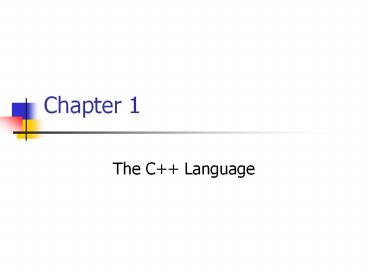The C Language - PowerPoint PPT Presentation
1 / 22
Title:
The C Language
Description:
Chapter 1 The C++ Language – PowerPoint PPT presentation
Number of Views:23
Avg rating:3.0/5.0
Title: The C Language
1
Chapter 1
- The C Language
2
Objectives
- Describe various types of programs
- Describe the role of the operating system
- Describe how a computer gets instructions
- Describe the role of the programming language,
high- and low-level languages, interpreters, and
compilers - Explain the structure of a C program
3
What is a computer program?
- Computers are just machines and must follow
directions. - Directions are grouped into logical sequences to
create programs. - Programs that perform specific tasks such as word
processing are called application programs. - When a computer is first turned on, it must
follow the instructions embedded in ROM.
4
Operating Systems
- The operating system takes charge of fundamental
system operations including - Managing hardware
- Maintaining file systems
- Controlling input and output
- Loading and executing programs
5
The Computers Language
- The microprocessor is the device that actually
processes the instructions given to the computer. - Each microprocessor has its own instruction set
that it can understand. - The instructions provided to the microprocessor
must be in machine language. - Machine language is a combination of circuits
that can be represented with the binary number
system.
6
Introduction to Programming Languages
- Programming languages can be understood by people
and computers. - Each language has its own set of rules and
vocabulary. - Some are very much like English, while others are
not.
7
Assembly Language
- Uses numbers and letters to represent machine
language instructions. - An assembler is needed to change the programmers
code into machine language. - Examples of statements might look like the
following - PUSH BP
- MOV BP, SP
- MOV SI, 0002
8
Low Level Languages
- It is necessary for the programmer to know the
instruction set of the microprocessor. - Programs are specific to a microprocessor.
- Low level programs take up less memory.
- You can do anything that the hardware will allow.
9
High-level Languages
- One command may represent many microprocessor
instructions. - You can write programs more quickly.
- Instructions are usually more easy to read.
- Easier to move between computers.
10
Examples of Languages
- High-level
- C
- Java
- Basic
- Pascal
- Visual Basic
- Low-level
- Machine language
- Assembly language
11
Interpreters
- Translate the source code of a high level
language into machine language code known as
object code. - Each instruction is interpreted as it is needed.
- The interpreter must be loaded into memory first.
- Object code is not saved.
12
Compilers
- Also translate high level source into object
code. - Makes the translation once and saves an object
file. - The object file is combined with other machine
language by the linker. - The linker generates the executable file.
13
C Program Structure
- C has some major elements
- Comments
- Compiler directives
- Main function
- Braces
- Statements
14
Comments
- Comments are ignored by the compiler.
- They are used to explain the purpose of the
program, explain the source code, identify the
parts of the program or store the names of the
programmers. - Comments begin with a double forward slash (//).
15
Compiler Directives
- Instructions to the compiler, not really part of
the C language. - A common directive is the include directive
which inserts other prewritten code into your
program. - Includes are usually used to add additional
functionality such as input/output to your
program.
16
Main function
- A function is a block of code that carries out a
specific task. - Programs are usually divided into many functions,
but the main function always runs first. - Functions are typically called from other parts
of the program and they might return a value.
17
Braces
- Braces are used to mark the beginning and end of
a block of code. - Aligning the indention of opening and closing
braces can make it easier to quickly identify
blocks of code.
18
Statements
- Statements are instructions that make the program
work. - Each statement must end with a semicolon.
- Directives and function declarations do not end
with semicolons. - C is case sensitive so capitalization in
statements does matter.
19
From source code to finished product
- Type source code into text editor.
- Compile the program into object code.
- Link the object code with other machine language
to generate an executable file. - The executable file can be run.
20
Summary
- Computers follow instructions called programs.
- Application programs perform specific tasks.
- Operating systems manage fundamental computer
activities. - The microprocessor processes each instruction.
21
Summary
- An interpreter or compiler must translate high
level languages into machine language. - Experience will teach you what language is
appropriate for a specific task. - Comments are ignored by the compiler.
- Directives are commands for the compiler.
22
Summary
- All C programs have a main function. The main
function is where the program begins running. - Braces mark the beginning and end of blocks of
code. - Statements are the lines of code the computer
executes. - Each statement ends with a semicolon.
- C is case sensitive and it ignores extra space.

